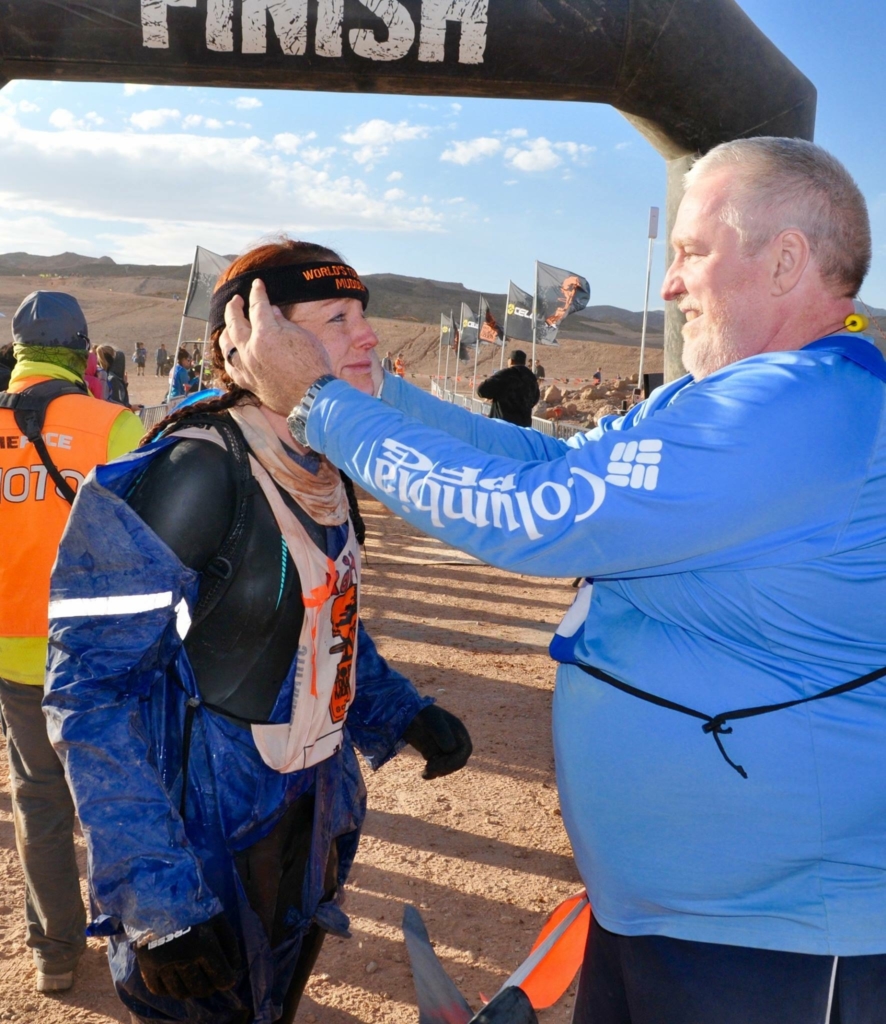
Last year I was a last-minute addition to Pit for my daughter Kait Karel. In the two weeks before the event, I read everything I could – besides watching the requisite Pis’and’Cox Pit Crew episode – and talked to multiple athletes about how I could best help my athlete. I threw in a few of my ideas. Kait rocked WTM 2015, and I was thrilled to be a part of it and to help where I could. This past spring we resurrected our Pit-Athlete act at BFX24 in Miami.
At both events, and many of the shorter OCR’s I’ve been a spectator at, I’ve been most impressed by the collegial community unique to this sport. My advice to other Pit Crews, especially first-timers and athletes having a Pit Crew for the first time, is to read the previous posts about How to Pit Crew (as I did before that first time). Many in the OCR community have been kind in including me in their friendship shenanigans and have complimented my Pit Crew approach. So in the spirit of sharing, here’s Doc’s Prescription for Pit Pride Performance:
The suggestions below should be reviewed with the athlete you are crewing. Hopefully, these ideas will give you both a general blueprint for maximizing success. Before the race, remember you are in service of your athlete: Your goal is to understand their goals, fears, strengths, needs and wants – to know them. There is no one-size-fits-all model to either how an athlete approaches the event, nor one “correct” approach as to how to serve in the Pit. Together, in advance, you will devise your strategy. In part that is because once the race begins, as Pit you will adopt the voice of consistency as your athlete’s mind and body become muddled. Ideally, the Pit will be able to keep the athlete on track for the athlete’s goals and needs. That bears repeating: The primary job of Pit is to be the athlete’s own “calm brain” to work in concert with the athlete’s “beat up brain” on the course.
How to do that:
KNOW YOUR ATHLETE.
The greater you can understand your athlete’s plan, motivation, strengths/weaknesses, and needs, the better you will be able to serve during the event. Of course, it is possible to Pit for an athlete you don’t know – such is often the case in the camaraderie of helping neighbors in the Pit area, and well demonstrated in the Orphan Tent in particular. But, helping “on the fly” mostly limits you to addressing the athlete’s expressed needs at the moment. Working out issues and plans beforehand is a powerful tool to maximizing performance.
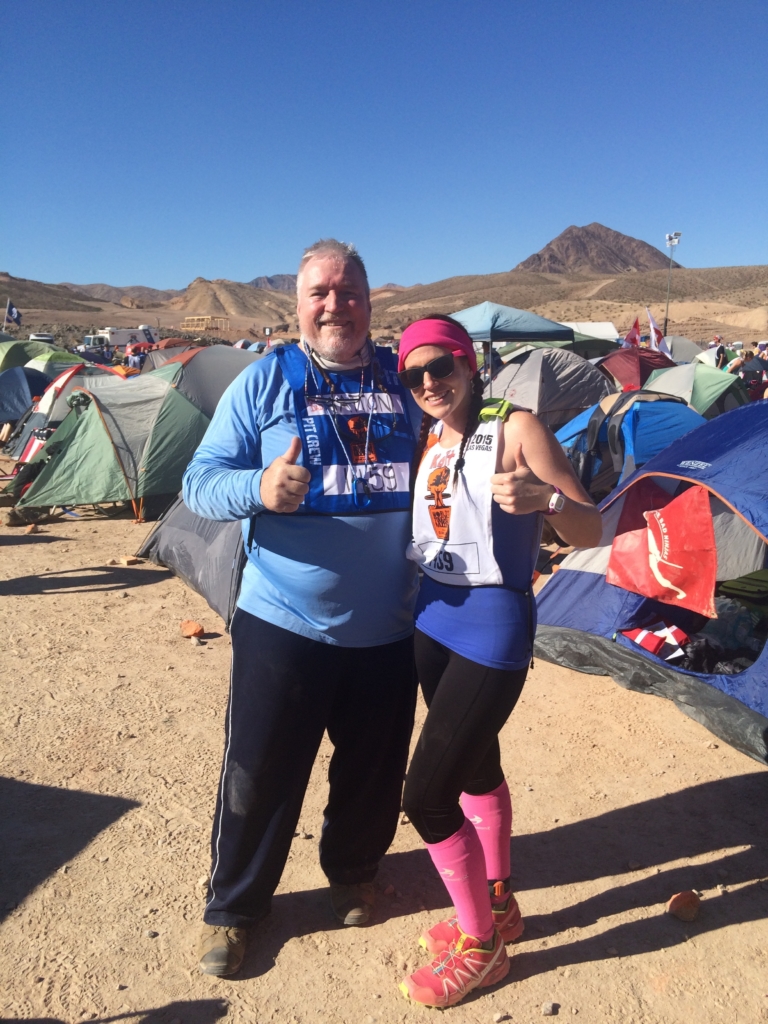
PRINT OUT THE RULES FOR THE EVENT IN ADVANCE (and bring a copy).
Don't overlook this. Understanding what you or your athlete can and can not do will avoid unnecessary DDQs OCR’s, especially the 24-hour events, are famous for their cooperative and supportive spirit. Helping others is part of the ethic of the event, ditto in the Pit. However, there are some things you can or cannot do (and if in doubt, find an event official to check). For example, at a Super Spartan our athlete had a medical DNF; her supply box was in the Pit area – as “spectators” we could NOT hand anything to another athlete or help them directly (it would DQ them), but we were able to announce what was in her box and offer that other competitors were welcome to take/borrow as needed (we’re still getting headlamps etc. mailed back, lol). Technicalities like finishing time/process and finisher-status are race specific – know them in advance, they will be necessary in planning strategy.
DEVELOP A PRE-RACE STRATEGY AND THREE CONTINGENCY PLANS.
Your primary plan is your quasi-realistic intent, i.e. at WTM15 our Plan “A” was “I want to be a finisher, earn my 25 mile patch and be able to achieve 10 laps if at all possible without permanently damaging myself”. That is the driving mantra (until/if reality intervenes). Plan “B” comes into effect if Plan “A” is not achievable. For Kait “Plan B” was: “I want to get my 25 mile patch and be a finisher”; then “C” I want to be a finisher”. Therefore, as her (calm brain) Pit Crew, I was to work inversely;
I was to prioritize her:
Not creating permanent injury to herself,
Then to keep her on pace to finish 10 laps,
(and if the above was impossible) To be sure she finished at least 25 miles
Lastly, even with injury, to attempt to get her back onto the course at the finish (to earn “Finisher Status”).
These were HER goals. Of course, on-course communication in real time is essential to mediating these goals. More so, the athlete’s trust that their Pit has the athlete’s best interests at heart allows them to listen and follow guidance even when hurting/fogged.
BE WELL STOCKED.
As Pit Crew, try to anticipate additional needs in advance. Yes, Pit Crew can leave the grounds while an athlete is on course, but you don’t want to be frantically looking for supplies you could have had on hand. At a minimum, review needs beforehand together and stock:
Basic first aid – (Unlike most camping ventures, you WILL use this stuff) At the least: Bandaids, antibiotic gel, nu-skin, rolled gauze, scissors, small clippers and nail clippers, safety pins, sun tan lotion, anti-chafing cream/stick, and race-specific needs (kinesiology tape, toe cream, butt crack spread, ankle/wrist bandages/supports, tape for wrapping, anti-inflammatories, salt pills, mustard, emergency blankets).
Basic OCR needs – toe gel, etc.
Mandatory equipment and back-ups: Such as water-proof headlamps, flashers, etc.
Athletes desired equipment: Wet suit, camelback (with back-up complete outfit and replaceable bladders), change of shoes (with one pair at least one size larger), change of clothes, gloves, pads, compression socks, “rain/wind” top, goggles.
Element gear: Sunglasses, sunscreen, lip balm sticks, burn cream (works for abrasions too), bug spray, face buffs, arm/leg protection, sand gaiters, floatation devices, etc.
Food: Both race-need and comfort based, targeting calories/energy, hydration, cramping, stimulation/caffeine.
Fun stuff. First, as Pit Crew you’ll have some time on your hands. Bring books, music and definitely a camera! My tent has martinis (what can I say?) and food to share with other Crews and athletes. It also has motivational notes, and a host of things I might pull out to get my athlete’s mood back on track.
BE WELL ORGANIZED
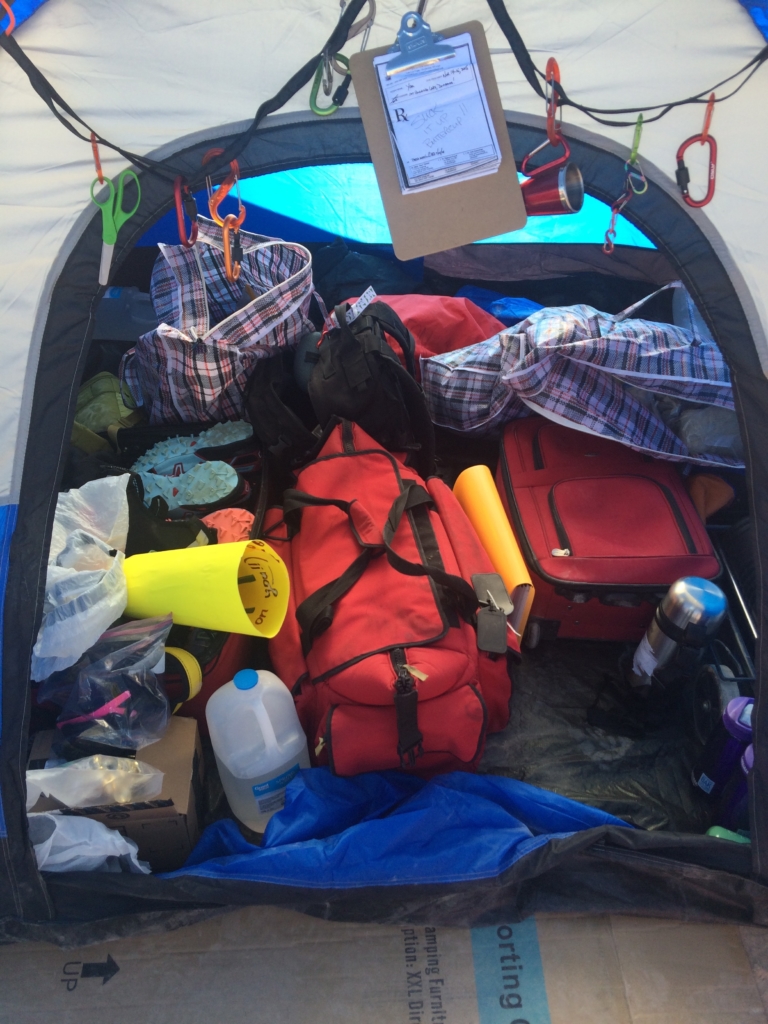 My athlete and I are a bit Obsessive Compulsive (If you’ve read this far, ya think?). A degree of organization is essential for an efficient Pit. This includes a buying list and packing-check-list before the event. At the Pit, it means knowing where everything is … and continuing to know as the 24-hours of chaos unfolds!
My athlete and I are a bit Obsessive Compulsive (If you’ve read this far, ya think?). A degree of organization is essential for an efficient Pit. This includes a buying list and packing-check-list before the event. At the Pit, it means knowing where everything is … and continuing to know as the 24-hours of chaos unfolds!
We use a task-specific system: Water in front corners of the tent (also serves to keep tent weighted during wind/sand storms), Clothes for during the event mid-right, gear center front, left front for “as needed.” In front of tent: First aid (in bags/box), grab-and-go food and electronics all in a collapsible wagon out front (which becomes the “staging area,” especially for quicker pits), plus refrigerated food in a cooler out front.
The rest goes in the back of tent (clothes for after, coats, tent supplies, sleeping bag, and mat, etc.). I also use a caribeaner system hung on the outside of the tent with items like scissors, a knife, suntan lotion, bug spray, lip balm, electrical tape, martini glasses, and other essentials in easy reach!
MUST HAVE PIT EQUIPMENT
Most events will assign you a 10’x10’ Pit plot. It’s important that all your pit gear fit inside that dimension, including you and your athlete as you are using stuff to attend to your athlete. At WTM, athletes entered the pit rows on narrow paths, so obviously any gear sticking into the path is hazardous, especially at night. (Note: At BFX24 the pit space was actually about 11’x11’, but count on a 10-foot square).
What you include in your pit will be strongly determined by whether you have to fly to the event city and exactly how much expendable cash you have (i.e. you can always buy whatever you need locally and donate afterward – but that gets costly). Do remember that you have to haul all that stuff in and out from the parking area to the pit! Don’t underestimate this fact, especially as a fatigue factor for the athlete (before and especially after). Here’s what we bring:
A small tent.
I suggest a 3-person size, which is ample for storage and shelter, including if raining. This size allows for a good amount of space for activity outside the tent as well s inside (if needed). Ours packs down small enough to fit in my airline checked duffle bag and therefore can be re-used event-to-event. It’s also under $40 because things get abused. Good ventilation and an easy access door(s) is needed, along with reasonable height. Our approach has been that both athlete and Pit Crew do NOT anticipate sleeping during the 24-hour event. But again, the option to lie down/sleep should always be viable if situations merit. Therefore we also bring…
One sleeping bag.
As packable as possible. We have a highly compact-able one which would offer adequate warmth if used. Don't forget; you will likely also have at least a jacket and emergency blankets (Mylar, etc.self inflating). To use if needed for warmth.We keep ours tightly packed in the compression sack and have not yet had to open it on site.
One inflatable mattress.
We use a Camp Rest, which is a bit large, but again rolls fairly small and fits in the one suitcase I pack as Pit Crew, and self-inflating. Besides padding, if needed for sleep, it can serve as an excellent base for stretching/yoga/massage.
Chair(s).
I would suggest one for each Pit member and one for the athlete (if you can handle the logistics). I have back issues and am a large guy (shout out to FGMBN and the Clydesdales), so I need a fairly good strong collapsable chair. I now carry one as airline carry-on in a sack; at worst they “gate check” it. At WTM we bought a cheap second chair for the athlete and then donated it. At BFX24 we used just the one chair (since the athlete is only briefly in the Pit and the crew is usually bustling getting stuff at that time).
Your choice, but at least one chair is needed. There is a lot of down time between the frantic pit stops. One of the highlights of being a Pit person is the camaraderie in the Pit area throughout the event. Plus being well rested as Pit is essential – It stuns me how many other athletes I have helped because their pit people were missing, asleep, etc. As a side note: In our prep my athlete has strict instructions to wake me whenever they come into the pit if I happen to have fallen asleep – again, discuss in advance.
Collapsable wagon.
I’m a big fan. BFX24 arranged (nearly at the last moment) that Pit parking was adjacent to the pit area, making haul in/out very easy. WTM was a much longer trek. Expect a trek. The wagon is a vast help, saving energy, but also being a compact organizational tool at the pit tent site. Plus it could be simply rolled in and out of the tent fully stocked and organized during periods of inclement weather.
Clothing
Your athlete should know what works for them and pack accordingly. However, once the pit area is set up, be sure to have your athlete show you where everything is (or reorganize it yourself) so swapping out clothes (shirts/socks usually), adding layers, etc. can be achieved easily and quickly. Regardless, your pit area should have items for warming-up between laps given the omnipresent threat of hypothermia. I bring several space blankets (since they take up little room/weight) and at least one warm coat (an old down winter coat of the athlete’s works great as it will get trashed at times!). Don’t forget layers for yourself in the Pit! Gloves, a hat, earmuffs, etc. aren’t overkill if you can fit them – you never know.
Those are the big gear essentials, but experience has led us to other “always bring” stuff, including:
Wide mouthed thermos (hot water for food, keeping prepped food hot, hot soup or beverages), thermal warming bags, eating/mixing/serving utensils, safety pins, patches, super glue, headlamps for pit crew). Critical note in planning ahead: Pit areas do not allow cooking or fire. The only source of heating for food is in the event tent or Orphan Tent, which will have hot water and microwaves. Microwaves are dependent on adequate electricity, which usually is highly variable. At WTM there was a significant block of time without any microwaves working. As a precaution, I now keep one thermos filled with boiling water. At worst, I can make something warming.
LAP CHECK LISTS.
My secret Pit weapon. Develop your own tailored to your athlete. We keep two charts. The first is a check-list to address what I need to do for my athlete on each lap as well as keep track what was done. It is both a preparation list for each lap, and a chart of what’s going on:
Start time (of each lap)
End time (of each lap)
Time in the Pit (for each lap)
What I need to prepare before a given lap (food, first aid, suntan lotion, supplements, etc.)
What else was actually done ( each lap/pit; i.e. changed shoes)
What did the athlete eat/consume (including calories, if possible)
What did the athlete drink (especially noting volume, for necessary hydration)
Did my athlete urinate? (further gauge of hydration etc.)
What food did I send them out with for the next lap?
What liquids (and volume) did I send them out with for the next lap?
Do they have their timer chip? (especially important during shoe/clothing/pack changes)
Do they have their headlamp?
Do they have their flasher? (or any other mandated equipment)
What do they want ready for their next pit? (food, medical, equipment, etc.)
The second check list I work on once my athlete has left the pit. It extrapolates the timing data to further highlight:
Time of each lap on course
Time for each lap in pit
A running mean average of each lap time on course (i.e. what pace is she on?)
A running man average of her combined lap time on course and pit time
Running mean average of the last two laps
This data helps to project the number of laps possible for your athlete, whether they need to pick up pace, and whether they need to alter their time in the pit. This is especially crucial for achieving the athlete’s overall mileage goals and for accurate advice on attempting final lap(s). For example, I was able to advise my athlete she needed to move two minutes faster on average than her last two laps and shorten her pit stops by two minutes is she wanted to reach her goal with two laps remaining at BFX24. Data eliminates guesswork and allows accurate feedback to the athlete. Pushing too hard, or conversely unknowingly slowly, can impact the athlete’s pre-race goals. A little record-keeping and number-crunching on the fly let you advise your athlete in a very meaningful way.
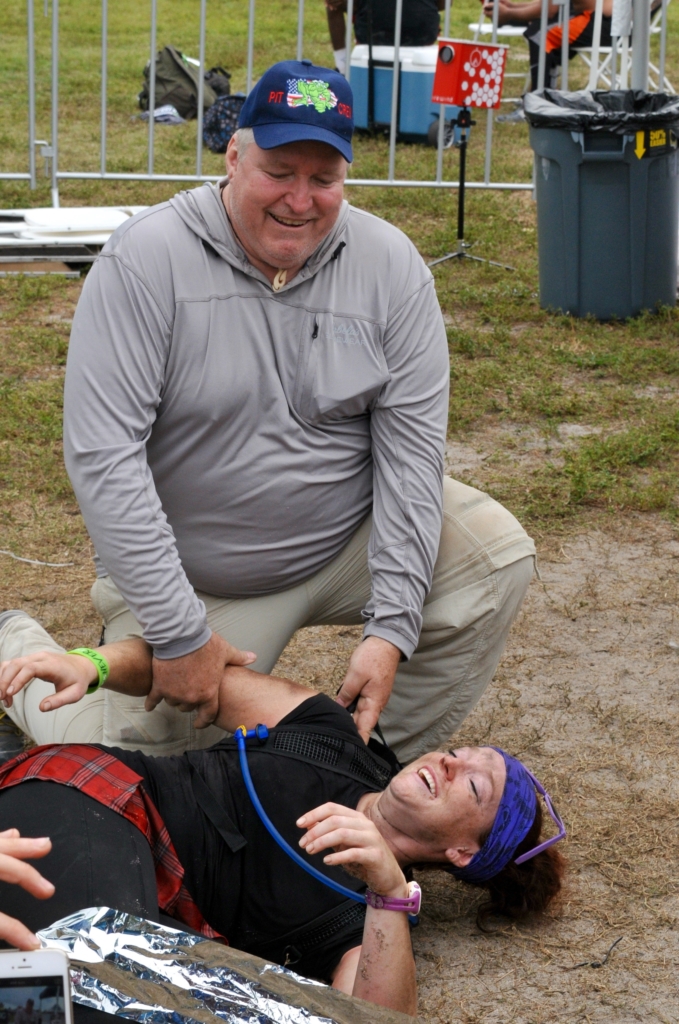
Don’t forget: YOU are your athlete’s organizational brain. Charts and data are your friend.
MAKE THE MOST OF THE EXPERIENCE
We’ve taken to making a very short video-clip at the end of each pit stop. This allows Pit Crew to upload and post online to friends and family back home who are rooting for your athlete. It also gives valuable data for later analysis as to future needs, conditioning, etc.
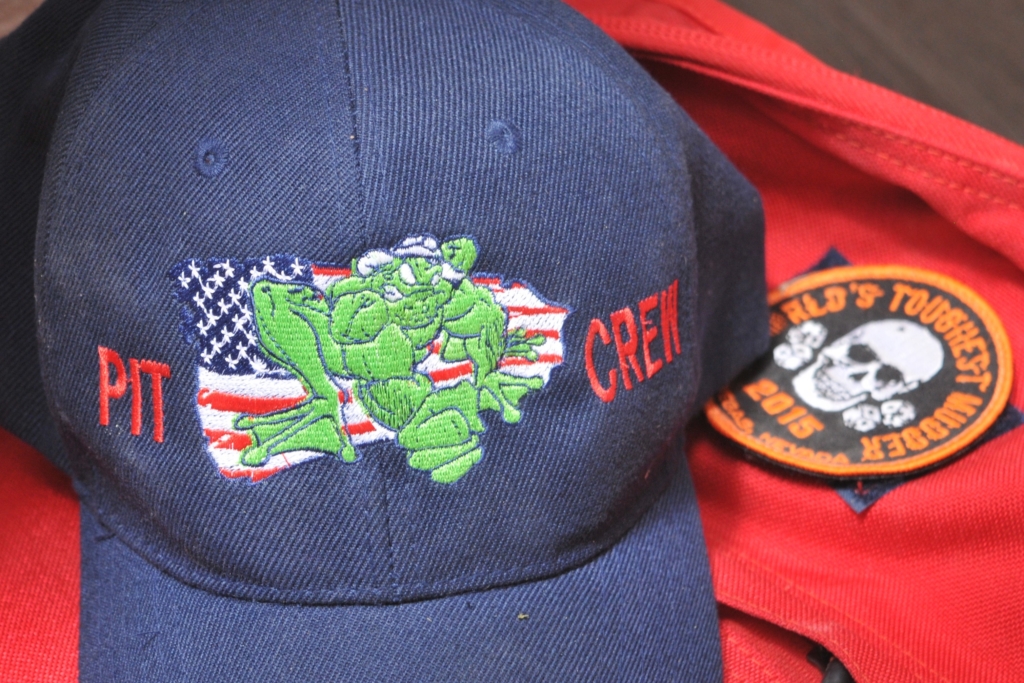
BEYOND THAT:
Help others. Cheer every athlete. Remind your athlete that you are proud of them and that they can do more. And take in the vibe, you will not find a more eclectic yet familial group of people. This is a surreal experience; listen to the bagpipes, watch the eerie line of athlete’s headlights snaking through the night, join in the encouragement in the Pits, hug, high five, cry, celebrate, console and bask in the beautiful raw humanity unfolding as you will have a unique front row seat.
Twenty-four-hour events take months of training and preparation. Maximize your athlete’s performance with equal training and service as Pit Crew. Those twenty-four hours will feel like they both grind on forever and pass in a blink – the only solace is that … you’ll likely be hooked and back again next year. Undoubtedly, with a few tweaks and improvements as to how athlete and Pit can combine to push the envelope even more.


Leave A Comment